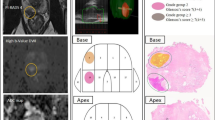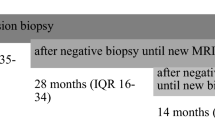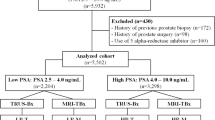Abstract
The purpose of this study is to report our method in detecting prostate cancer (PCa) using an 18-core transrectal ultrasound (TRUS) prostate biopsy (PB) schema, in combination with additional targeted cores from suspicious images in conventional (e-cMRI) and functional (e-fMRI) endorectal magnetic resonance imaging (e-MRI) of the prostate. From 2004 to 2008, 260 consecutive patients with a clinical suspicion of PCa underwent PB and were prospectively studied. e-cMRI and e-fMRI was performed in all patients before PB. The patients were divided into two groups (A and B) according to the results of their radiological findings (group A=suspicious findings, group B=non-suspicious findings). After the images were processed, an 18-core TRUS-guided PB was performed. When a patient exhibited a suspicious site on e-cMRI and e-fMRI images, three additional targeted PBs were obtained from that site. In group A, 17.5% of PCa was detected by the 18-core PB and 56.5% of PCa was detected by the targeted cores. The overall PCa detection rate (18+targeted cores) was 73.9%. The overall specificity was 73.9%. In group B, overall false-positive detection rate reached 19.2%, with the overall sensitivity being 80.8%. The method described above is not only practical but also a promising modality in PCa detection. As seen, PCa was optimally detected when combining the 18-core and targeted-core PB schema together. Non-suspicious images do not rule out the probability of PCa, thus justifying a PB in these patients as well.
This is a preview of subscription content, access via your institution
Access options
Subscribe to this journal
Receive 4 print issues and online access
$259.00 per year
only $64.75 per issue
Buy this article
- Purchase on Springer Link
- Instant access to full article PDF
Prices may be subject to local taxes which are calculated during checkout



Similar content being viewed by others
References
Sarma AV, Schottenfeld D . Prostate cancer incidence, mortality, and survival trends in the United States: 1981–2001. Semin Urol Oncol 2002; 20: 3–9.
Fink KG, Schmid HP, Paras L, Schmeller NT . Prostate biopsy in Central Europe: results of a survey of indication, patient preparation and biopsy technique. Urol Int 2007; 79: 60–66.
Davis M, Sofer M, Kim SS, Soloway MS . The procedure of transrectal ultrasound guided biopsy of the prostate: a survey of patient preparation and biopsy technique. J Urol 2002; 167: 566–570.
Hersh MR, Knapp EL, Choi J . Newer imaging modalities to assess tumour in the prostate. Cancer Control 2004; 11: 353–357.
BeyersdorV D, Winkel A, Hamm B, Lenk S, Loening SA, Taupitz M . MR imaging-guided prostate biopsy with a closed MR unit at 1.5 T: initial results. Radiology 2005; 234: 576–581.
Aigner F, Pallwein L, Pelzer A, Schaefer G, Bartsch G, Nedden DZ et al. Value of magnetic resonance imaging in prostate cancer diagnosis. World J Urol 2007; 25: 351–359.
Schnall MD, Pollack HM . Magnetic resonance imaging of the prostate. Urol Radiol 1990; 12: 109–114.
Choyke PL . Contrast agents for imaging tumor angiogenesis: is bigger better? Radiology 2005; 235: 1–2.
Buckley DL, Roberts C, Parker GJ, Logue JP, Hutchinson CE . Prostate cancer: evaluation of vascular characteristics with dynamic contrast enhanced T1-weighted MR imaging—initial experience. Radiology 2004; 233: 709–715.
Tien RD, Felsberg GJ, Friedman H, Brown M, MacFall J . MR imaging of high-grade cerebral gliomas: value of diffusion-weighted echoplanar pulse sequences. AJR Am J Roentgenol 1994; 162: 671–677.
Jemal A, Thomas A, Murray T, Thun M . Cancer Statistics, 2002. CA Cancer J Clin 2002; 52: 23–47.
Rullis I, Shaeffer JA, Lilien OM . Incidence of prostatic carcinoma in the elderly. Urology 1975; 6: 295–297.
Scattoni V, Zlotta A, Montironi R, Schulman C, Rigatti P, Montorsi F . Extended and saturation prostatic biopsy in the diagnosis and characterisation of prostate cancer: a critical analysis of the literature. Eur Urol 2007; 52: 1309–1322.
Hodge KK, McNeal JE, Stamey TA . Ultrasound guided transrectal core biopsies of the palpably abnormal prostate. J Urol 1989; 142: 66–70.
Stewart CS, Leibovich BC, Weaver AL, Lieber MM . Prostate cancer diagnosis using a saturation needle biopsy technique after previous negative sextant biopsies. J Urol 2001; 166: 86–91.
Fleshner NE, O’Sullivan M, Fair WR . Prevalence and predictors of a positive repeat transrectal ultrasound guided needle biopsy of the prostate. J Urol 1997; 158: 505–509.
Crawford ED, Hirano D, Werahera PN, Lucia MS, DeAntoni EP, Daneshgari F et al. Computer modeling of prostate biopsy: tumor size and location-not clinical significance-determine cancer detection. J Urol 1998; 159: 1260–1264.
Inahara M, Suzuki H, Kojima S, Komiya A, Fukasawa S, Imamoto T et al. Improved prostate cancer detection using systematic 14-core biopsy for large prostate glands with normal digital rectal examination findings. Urology 2006; 68: 815–819.
Philip J, Ragavan N, Desouza J, Foster CS, Javle P . Effect of peripheral biopsies in maximising early prostate cancer detection in 8-, 10- or 12-core biopsy regimens. BJU Int 2004; 93: 1218–1220.
Borboroglu PG, Comer SW, Riffenburgh RH, Amling CL . Extensive repeat transrectal ultrasound guided prostate biopsy in patients with previous benign sextant biopsies. J Urol 2000; 163: 158–162.
Guichard G, Larre S, Gallina A, Lazar A, Faucon H, Chemama S et al. Extended 21-sample needle biopsy protocol for diagnosis of prostate cancer in 1000 consecutive patients. Eur Urol 2007; 52: 430–435.
Walz J, Graefen M, Chun FK, Erbersdobler A, Haese A, Steuber T et al. High incidence of prostate cancer detected by saturation biopsy after previous negative biopsy series. Eur Urol 2006; 50: 498–505.
Kirkham AP, Emberton M, Allen C . How good is MRI at detecting and characterising cancer within the prostate? Eur Urol 2006; 50: 1163–1174.
Vilanova JC, Comet J, Capdevila A, Barceló J, Dolz JL, Huguet M et al. The value of endorectal MR imaging to predict positive biopsies in clinically intermediate-risk prostate cancer patients. Eur Radiol 2001; 11: 229–235.
Comet-Batlle J, Vilanova-Busquets JC, Saladié-Roig JM, Gelabert-Mas A, Barceló-Vidal C . The value of endorectal MRI in the early diagnosis of prostate cancer. Eur Urol 2003; 44: 201–207.
Beyersdorff D, Taupitz M, Winkelmann B, Fischer T, Lenk S, Loening SA et al. Patients with a history of elevated prostate-specific antigen levels and negative transrectal US-guided quadrant or sextant biopsy results: value of MR imaging. Radiology 2002; 224: 701–706.
Yuen JS, Thng CH, Tan PH, Khin LW, Phee SJ, Xiao D et al. Endorectal magnetic resonance imaging and spectroscopy for the detection of tumor foci in men with prior negative transrectal ultrasound prostate biopsy. J Urol 2004; 171: 1482–1486.
Hara N, Okuizumi M, Koike H, Kawaguchi M, Bilim V . Dynamic contrast-enhanced magnetic resonance imaging (DCE-MRI) is a useful modality for the precise detection and staging of early prostate cancer. Prostate 2005; 62: 40–47.
Anastasiadis AG, Lichy MP, Nagele U, Kuczyk MA, Merseburger AS, Hennenlotter J et al. MRI-guided biopsy of the prostate increases diagnostic performance in men with elevated or increasing PSA levels after previous negative TRUS biopsies. Eur Urol 2006; 50: 738–748.
Yu KK, Hricak H, Alagappan R, Chernoff DM, Bacchetti P, Zaloudek CJ . Detection of extracapsular extension of prostate carcinoma with endorectal and phased-array coil MR imaging: multivariate feature analysis. Radiology 1997; 202: 697–702.
Acknowledgements
Parts of this study have been obtained with the permission of Mr Sami Takriti from his doctoral thesis.
Author information
Authors and Affiliations
Corresponding author
Rights and permissions
About this article
Cite this article
Labanaris, A., Engelhard, K., Zugor, V. et al. Prostate cancer detection using an extended prostate biopsy schema in combination with additional targeted cores from suspicious images in conventional and functional endorectal magnetic resonance imaging of the prostate. Prostate Cancer Prostatic Dis 13, 65–70 (2010). https://doi.org/10.1038/pcan.2009.41
Received:
Accepted:
Published:
Issue Date:
DOI: https://doi.org/10.1038/pcan.2009.41
Keywords
This article is cited by
-
Role of MRI in diagnosis of prostate cancer and correlation of results with transrectal ultrasound guided biopsy “TRUS”
Egyptian Journal of Radiology and Nuclear Medicine (2022)
-
Accuracy of multiparametric magnetic resonance imaging for diagnosing prostate Cancer: a systematic review and meta-analysis
BMC Cancer (2019)
-
Prostate cancer detection in patients with prior negative biopsy undergoing cognitive-, robotic- or in-bore MRI target biopsy
World Journal of Urology (2018)
-
Everyman’s prostate phantom: kiwi-fruit substitute for human prostates at magnetic resonance imaging, diffusion-weighted imaging and magnetic resonance spectroscopy
European Radiology (2017)
-
Recent advances in image-guided targeted prostate biopsy
Abdominal Imaging (2015)



